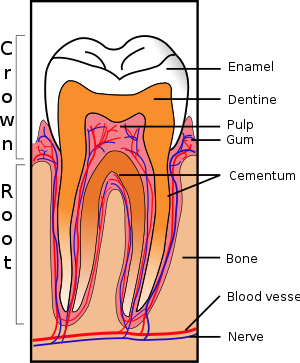Cracked tooth syndrome
| Cracked tooth syndrome | |
|---|---|
 |
|
| Cross-section of a posterior tooth. | |
| Classification and external resources | |
| ICD-9-CM | 521.81 |
Cracked tooth syndrome (abbreviated to CTS, and also termed cracked cusp syndrome,split tooth syndrome, or incomplete fracture of posterior teeth), is where a tooth has incompletely cracked but no part of the tooth has yet broken off. Sometimes it is described as a greenstick fracture. The symptoms are very variable, making it a notoriously difficult condition to diagnose.
Cracked tooth syndrome could be considered a type of dental trauma and also one of the possible causes of dental pain. One definition of cracked tooth syndrome is "a fracture plane of unknown depth and direction passing through tooth structure that, if not already involving, may progress to communicate with the pulp and/or periodontal ligament."
The reported symptoms are very variable, and frequently have been present for many months before the condition is diagnosed. Reported symptoms may include some of the following:
If the crack propagates into the pulp, irreversible pulpitis, pulpal necrosis and periapical periodontitis may develop, with the respective associated symptoms.
CTS is typically characterized by pain when releasing biting pressure on an object. This is because when biting down the segments are usually moving apart and thereby reducing the pressure in the nerves in the dentin of the tooth. When the bite is released the "segments" snap back together sharply increasing the pressure in the intradentin nerves causing pain. The pain is often inconsistent, and frequently hard to reproduce. If untreated, CTS can lead to severe pain, possible pulpal death, abscess, and even the loss of the tooth.
If the fracture propagates into the pulp, this is termed a complete fracture, and pulpitis and pulp death may occur. If the crack propagates further into the root, a periodontal defect may develop, or even a vertical root fracture.
According to one theory, the pain on biting is caused by the 2 fractured sections of the tooth moving independently of each other, triggering sudden movement of fluid within the dentinal tubules. This activates A-type nociceptors in the dentin-pulp complex, reported by the pulp-dentin complex as pain. Another theory is that the pain upon cold stimuli results from leak of noxious substances via the crack, irritating the pulp.
...
Wikipedia
